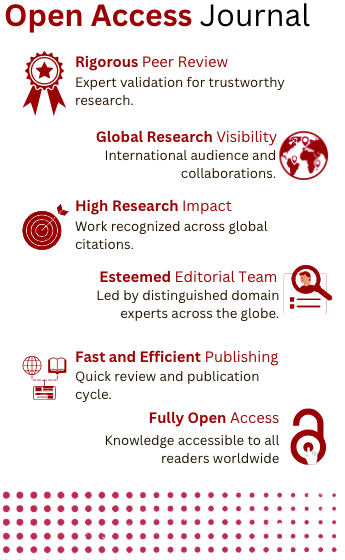AI-Powered Framework for Evaluating Child-Friendly Mobile Applications
DOI:
https://doi.org/10.5281/zenodo.15624307Keywords:
Child Safety, Mobile Applications, User Reviews, Machine Learning, Natural Language Processing (NLP), Text ClassificationAbstract
As mobile applications increasingly shape children's digital interactions, ensuring their safety and suitability has become critical. This study introduces ML-CFA (Machine Learning for Child-Friendly Applications), a novel framework that classifies mobile apps as appropriate or potentially harmful for young users based on user-generated reviews. The proposed system leverages a robust Natural Language Processing (NLP) pipeline incorporating sentiment analysis, semantic feature extraction, and multiple ML algorithms, including Support Vector Machine (SVM), Naïve Bayes, Logistic Regression, Random Forest, and Convolutional Neural Networks. To assess model reliability, 10-fold cross-validation was applied to a labeled dataset of app reviews. The following metrics were used for evaluation: F1-score, accuracy, precision, recall, and Matthews Correlation Coefficient (MCC). SVM showed the most incredible consistency and generalization among all classifiers, with 98.72% accuracy, 0.984 precision, 0.979 recall, 0.986 F1-score, and 0.975 MCC. Additional studies emphasized the importance of resampling strategies, text preparation, and review score aspects. Preprocessing and undersampling, in particular, significantly increased MCC from 0.472 to 0.627 and enhanced semantic clarity. By automatically classifying app reviews, our results validate how well ML-CFA promotes children's internet safety.References
Papadakis, S., & Kalogiannakis, M. (2017). Mobile educational applications for children: What educators and parents need to know. International Journal of Mobile Learning and Organisation, 11(3), 256–277.
Majebi, N. L., & Drakeford, O. M. (2025). Child safety in the digital age: Historical lessons from media regulation and their application to modern cybersecurity policies. [Manuscript in preparation or unpublished work].
Pardhi, P. (2025). Content moderation of generative AI prompts. SN Computer Science, 6(4), 329.
Li, M., Lv, Y., Pu, Y., & Wu, M. (2025). Design and evaluation of children’s education interactive learning system based on human-computer interaction technology. Scientific Reports, 15(1), 6135.
Liu, M., Wang, H., Guo, Y., & Hong, J. (2016). Identifying and analyzing the privacy of apps for kids. In Proceedings of the 17th International Workshop on Mobile Computing Systems and Applications (pp. 105–110).
Mulligan, C., Gillis, G., Remedios, L., Parsons, C., Vergeer, L., & Potvin Kent, M. (2025). Children’s digital privacy on fast-food and dine-in restaurant mobile applications. PLOS Digital Health, 4(2), e0000723.
Hu, B., Liu, B., Gong, N. Z., Kong, D., & Jin, H. (2015). Protecting your children from inappropriate content in mobile apps: An automatic maturity rating framework. In Proceedings of the 24th ACM International Conference on Information and Knowledge Management (pp. 1111–1120).
Chen, Y., Xu, H., Zhou, Y., & Zhu, S. (2013). Is this app safe for children? A comparison study of maturity ratings on Android and iOS applications. In Proceedings of the 22nd International Conference on World Wide Web (pp. 201–212).
Thun, L. J., Teh, P. L., & Cheng, C.-B. (2022). CyberAid: Are your children safe from cyberbullying? Journal of King Saud University - Computer and Information Sciences, 34(7), 4099–4108.
Bengio, Y. (2012). Deep learning of representations for unsupervised and transfer learning. In Proceedings of ICML Workshop on Unsupervised and Transfer Learning (pp. 17–36). JMLR Workshop and Conference Proceedings.
Sadiq, S., Umer, M., Ullah, S., Mirjalili, S., Rupapara, V., & Nappi, M. (2021). Discrepancy detection between actual user reviews and numeric ratings of Google App Store using deep learning. Expert Systems with Applications, 181, 115111.
Meng, X., Li, S., Malik, M. M., & Umer, Q. (2022). Machine-learning-based suitability prediction for mobile applications for kids. Sustainability, 14(19), 12400.
Hua, Y., Stead, T. S., George, A., & Ganti, L. (2025). Clinical risk prediction with logistic regression: Best practices, validation techniques, and applications in medical research. Academic Medicine & Surgery. [In press]
Zhou, Z.-H. (2025). Ensemble methods: Foundations and algorithms. CRC Press.
Kihal, M., & Hamza, L. (2025). Efficient Arabic and English social spam detection using a transformer and 2D convolutional neural network-based deep learning filter. International Journal of Information Security, 24(1), 1–14.
Ahmed, S. T., Fathima, A. S., & Reema, S. (2023, December). An Improved System for Students Feedback Analysis Using Supervised Probability Techniques. In 2023 10th IEEE Uttar Pradesh Section International Conference on Electrical, Electronics and Computer Engineering (UPCON) (Vol. 10, pp. 328-333). IEEE.
Downloads
Published
How to Cite
Issue
Section
License
Copyright (c) 2025 Rajesh Lingam

This work is licensed under a Creative Commons Attribution-NonCommercial-NoDerivatives 4.0 International License.







